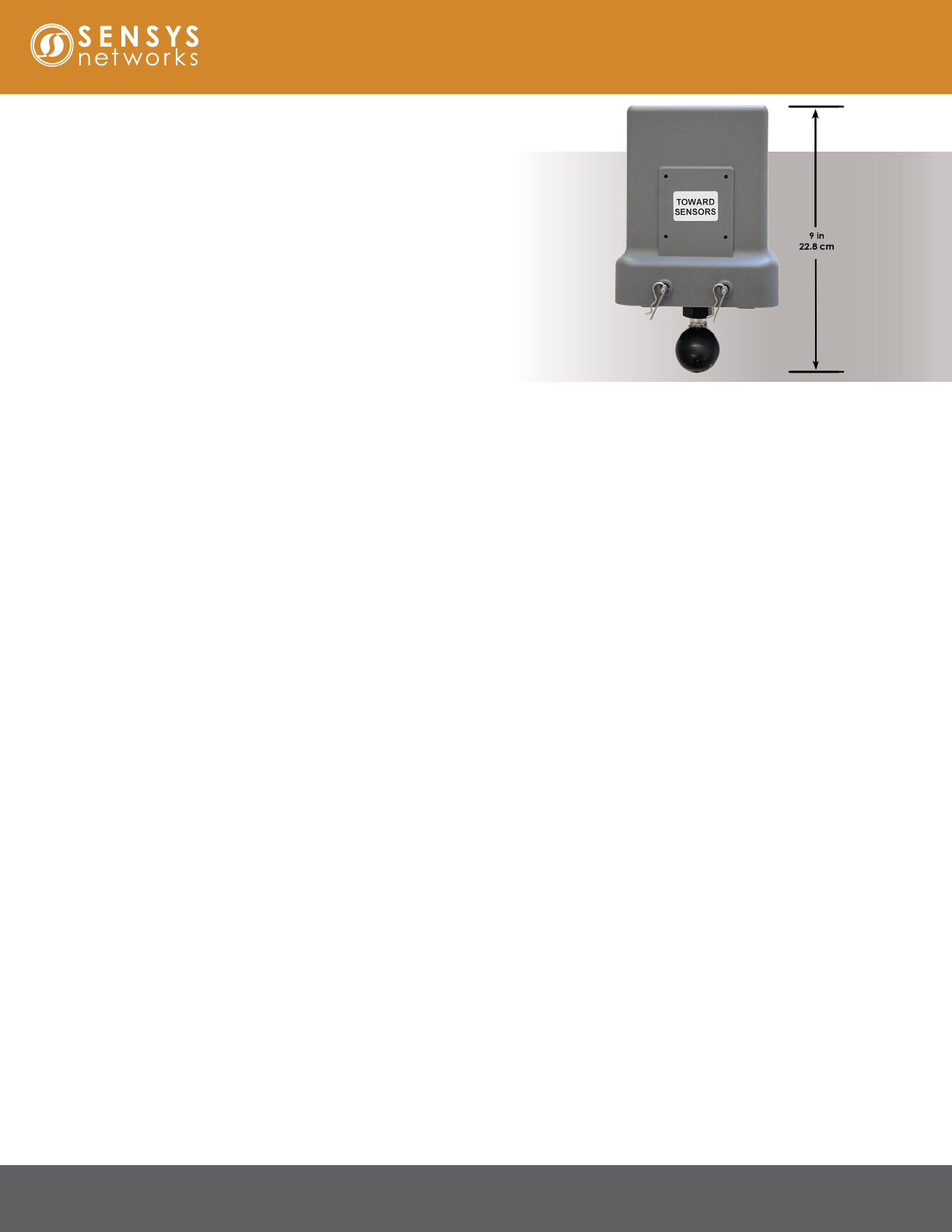Sensys Networks FLEX-AP FlexAP User Manual AP240 Access Point
Sensys Networks, Inc. FlexAP AP240 Access Point
User Manual

1608 4th Street Suite 200 Berkeley CA 94710 | www.sensysnetworks.com/resources| P 510.548.4620 F 510.548.8264
Functions / Features (cont.)
Relay of sensor data (cont.)
• Via IP connectivity (wired or wireless) to trac
management systems, upstream servers, etc.
Processing of sensor data
• Per-lane or per-vehicle data
• Data binning over selectable time intervals
• Data ltering (e.g., adaptive holdover)
Storage of sensor data
• Data buering (event caching)
• Data storage (processed data)
Master timebase for all supported wireless sensors
• Common clock for sensor timestamps
• Can be synchronized to NIST timing signals
Radio signal quality measurements
• Receive Signal Strength Indicator (RSSI, in dBm)
• Link Quality Index (LQI, gure of merit 40-99)
Firmware upgrades
• Upgrades via IP connectivity or via local PC connection
• Delivers upgrades to all other Sensys Networks devices
Simple installation
• Any roadside location that provides adequate signal
coverage to sensors/repeaters
• No special requirements regarding setback or mounting
stability
Enclosure
• Robust protection against outside environment
• Cable connects straight to board, removing one bulkhead
connection on the outside of enclosure
Software Compatibility
• Requires TracDOT software 2.12.7 or later
FlexAP
The Sensys Networks VDS240 Wireless Vehicle Detection System
uses pavement-mounted magnetometer or MicroRadar® sensors
to detect the presence and movement of vehicles and bicycles. The
magnetometer and MicroRadar® sensors are wireless, transmitting their
detection data in real-time via low-power radio technology to a nearby
Sensys Networks access point that then relays the data to one or more
local or remote trac management controllers and systems.
The Sensys Networks FlexAP is an intelligent device operating under
the Linux operating system that maintains two-way wireless links to
a vehicle detection system’s sensors and repeaters, establishes overall
time synchronization, transmits conguration commands and message
acknowledgements, and receives and processes data from the sensors.
The FlexAP then relays the sensor detection data to a roadside trac
controller or remote server, trac management system, or other vehicle
detection application.
The FlexAP is the second generation of Sensys Networks access points
and replaces the AP240. The FlexAP includes a higher sensitivity
radio for more robust wireless links and more processing and memory
capacity for additional applications. The FlexAP is housed in a robust
enclosure that provides excellent protection against the environment.
Types of FlexAPs. A FlexAP uses a single cable to support
10/100Base-T Ethernet communications and, in some versions,
serial communications to the contact closure card that furnishes the
interface to standard trac controllers.
FLEX-AP-S, FLEX-AP-ES
• RJ45 port supports serial interface to Contact Closure card
(CC card) for relay of vehicle detection output via the EX cards or
FlexConnect SDLC link
• Supports Ethernet interface for eld conguration (via Sensys
Networks AccessBox)
• Statistics processing of sensor detection data only in FLEX-AP-ES
• 48VDC power input from CC card via RJ45 port
FLEX-AP-D, FLEX-AP-ED
• RJ45 port supports Power-over-Ethernet (PoE) interface for relay
of detection data directly to controller
• Supports eld conguration over the Ethernet interface
• Statistics processing of sensor detection data only in FLEX-AP-ED
• 48VDC power input from PoE interface (adapter required)
Functions / Features
Sensys Networks radio communications
• To/from wireless sensors
• To/from repeaters
Relay of sensor data
• Via contact closure signals, FlexConnect SDLC link, or Ethernet
interface to trac controller

Sensys Networks and the Sensys Networks logo are trademarks of Sensys Networks, Inc. All other trademarks are the property of their respective owners.
Information contained herein is believed to be reliable, but Sensys Networks makes no warranties as to its accuracy or completeness.
Copyright © 2017 Sensys Networks, Inc. • ALL RIGHTS RESERVED • CONTENTS SUBJECT TO CHANGE
Local Distributor
FlexAP
Functional Specications
interfaces
• to/from sensors via 802.15.4 PHY radio
• to/from repeaters via 802.15.4 PHY radio
• to/from conguration device (PC) via
TCP/IP over 10/100Base-T Ethernet
• to roadside trac controller via contact
closure, SDLC link, or Ethernet interface
• to/from central network management/
data collection facilities via TCP/IP
IP connectivity
• Telnet, FTP, HTTP, PPP, PPTP, optional
encryption over tunnel
• 10/100Base-T via RJ45 connector
per-lane data
processing
• counts (volume)
• occupancy
• average and median speeds
• binned speeds and vehicle lengths over
selectable time intervals
per-vehicle data
processing
• initial vehicle detect time
• gap
• speed
• length
memory
resources
• ~500 kB for event caching
• ~1 MB for processed data storage
processor
• 400 MHz ARM9 processor
• Linux 3.14 operating system
• 256 MB Flash
• 128 MB SDRAM
over-the-air proto-
col Sensys NanoPower (SNP) protocol (TDMA)
physical layer
protocol IEEE 802.15.4 PHY
modulation
Direct Sequence Spread Spectrum Oset
Quadrature Phase-Shift Keying (DSSS
O-QPSK)
transmit/receive bit
rate 250 kbps
frequency band 2400 to 2483.5 MHz (ISM unlicensed band)
frequency channels 16
channel bandwidth 2 MHz
antenna type microstrip patch antenna (side with Toward
Sensors label)
antenna eld of
view ±60° (azimuth & elevation)
nominal output
power +3 dBm
spurious emissions
• 30 - 1000 MHz: < -36 dBm
• 1 - 12.75 GHz: < -30 dBm
• 1.8 - 1.9 GHz: < -47 dBm
• 5.15 - 5.3 GHz: < -47 dBm
typical receive
sensitivity -101 dBm (PER ≤ 1%)
saturation
(max input level) ≥ 10 dBm
Power, Physical, & Environmental
input voltage • via PoE cable to RJ45 connector
• 36-58 VDC (48 VDC nominal)
power
consumption • FLEX-AP-S, -D, -ED, -ES: 2 W
dimensions • 9” x 4.8” x 3.8”/22.8 cm x 12.1 cm x 9.6 cm
weight • FLEX-AP-S, -D, -ED, -ES: 1.6 lbs/0.7 kg
• mounting kit: add’l 1.2 lbs/0.5 kg
environmental • designed for weatherproof, outdoor operation
operating temp -40ºF to +176ºF/-40ºC to +80ºC
Order
Codes
stats
processing
capability
detection data interfaces
contact
closure SDLC 10/100 Base-T
FLEX-AP-S ● ● ●
FLEX-AP-ES ● ● ● ●
FLEX-AP-D ●
FLEX-AP-ED ● ●
Types of Access Points
Compliance
EMC
• FCC: This device complies with Part 15 of the FCC
rules. Operation is subject to the following two
conditions: (1) This device may not cause harmful
interference, and (2) this device must accept any
interference received, including interference that
may cause undesired operation.
• Note: Any changes or modications not expressly
approved by the party responsible for compliance
could void the user’s authority to operate the
equipment.
• IC: This device complies with Industry Canada
licence-exempt RSS standard(s). Operation is subject
to the following two conditions: (1) this device may
not cause interference, and (2) this device must
accept any interference, including interference that
may cause undesired operation of the device.
• IC : Le présent appareil est conforme aux CNR
d’Industrie Canada applicables aux appareils radio
exempts de licence. L’exploitation est autorisée
aux deux conditions suivantes : (1) l’appareil ne
doit pas produire de brouillage, et (2) l’utilisateur
de l’appareil doit accepter tout brouillage
radioélectrique subi, même si le brouillage est
susceptible d’en compromettre le fonctionnement.